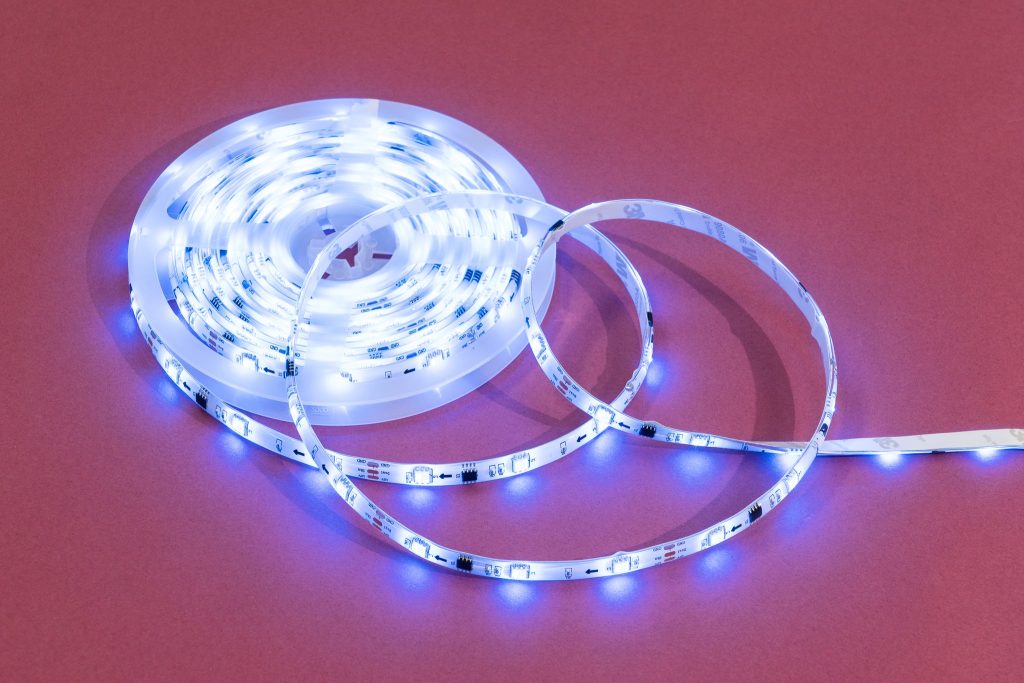LED Strip Light
LED strip lights are an exceptional choice for enhancing any space’s visual appeal and functionality. These versatile lighting options deliver a broad spectrum of color and brightness, making them perfect for ambient lighting in living rooms, task lighting in kitchens, or accent lighting in hallways and alcoves. The initial step in integrating LED strips into your design involves assessing the required brightness level to ensure you select a strip with the appropriate power capacity. This thoughtful consideration guarantees that your lighting solution meets and exceeds your expectations for aesthetics and performance.

What is an LED Strip Light?
LED strip lights are innovative lighting solutions that combine flexibility with efficiency. They are designed to offer vibrant colors and adjustable brightness levels, providing an ideal alternative to traditional incandescent and halogen bulbs. With their minimal heat production and capability for dynamic lighting effects, LED strips are perfect for various applications, from accentuating architectural details to enhancing the ambiance of living spaces.
These strips consist of multiple LED chips mounted on flexible circuit boards, allowing for installation in lengths tailored to specific needs. The illumination level of an LED strip is determined by the density of its LED chips and its overall brightness capacity, enabling users to select options that best fit their project’s requirements.
How do you Install LED Strip Lights?
Installing LED strip lights is straightforward, thanks to their adhesive backing, which resembles nearly any surface. To ensure a successful installation, start by cleaning the intended area thoroughly. Measure the space accurately, considering any gaps or overlaps, and cut the strip to length using scissors. Connecting the power terminals correctly and using compatible connectors to avoid electrical issues is crucial. Finally, power the strip to bring your space to life with light.
Where to Cut LED Light Strips?
Customizing LED strip lengths is easy, with designated cutting points marked by copper dots or scissors icons. These points, typically located every three LEDs, guide where cuts can be safely made without damaging the strip’s functionality. Always disconnect the strip from power before cutting to prevent accidents, then reattach the ends with the appropriate connectors, ensuring polarity alignment for a seamless operation.
How to Hardwire LED Strip Lights?
Hardwiring LED strip lights can be more suitable for a permanent lighting solution than plug-in adapters. This involves connecting the strip directly to a power source, requiring knowledge of the strip’s wattage and the power supply’s capacity to ensure compatibility. Selecting the right power supply involves considering the strip’s power consumption per foot and ensuring the supply can handle the total load.
How do you Fix LED Strip Lights That Won’t Turn On?
When LED strip lights fail to illuminate, the cause could range from voltage issues to power supply inadequacies. Troubleshooting should start with verifying the power source and checking for any loose connections. If problems persist, examining the strip for damage or consulting manufacturer guidelines may help identify a solution, such as replacing the strip or adjusting the power setup.
How to Reset LED Strip Lights?
Resetting LED strip lights can resolve connectivity issues or restore factory settings. This is typically done through a reset button found on the controller or the strip itself. Pressing this button resets the system, potentially fixing operational glitches. If issues like unexpected non-operation occur, a reset coupled with checking for power supply consistency can often remedy the situation.
Best LED Strip Lights
Selecting the best LED strip lights involves considering their intended use, desired brightness, and color temperature. Modern strips offer a range of features, including waterproofing for outdoor use and smart control capabilities for convenience. It’s essential to match the strip’s specifications with the installation space’s requirements to ensure optimal lighting results and safety.